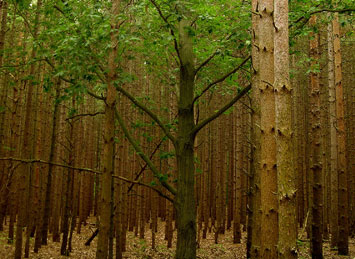Forest ecosystem more than just trees
The spring season is an excellent time to venture into Michigan’s vast forestlands to enjoy many of the plants, wildlife, mushrooms and other elements of a forest ecosystem.
 The famous idiom “can’t see the forest for the trees” typically refers to someone who is so focused on one thing they fail to see the big picture. And when you look at a real forest it’s easy to just focus on the trees – simply because they are a dominate part of the ecosystem. But a forest ecosystem is much more than just trees. And spring is an excellent time for people to go into woods, explore a forest and begin to learn and appreciate all the other components at work in a forest ecosystem.
The famous idiom “can’t see the forest for the trees” typically refers to someone who is so focused on one thing they fail to see the big picture. And when you look at a real forest it’s easy to just focus on the trees – simply because they are a dominate part of the ecosystem. But a forest ecosystem is much more than just trees. And spring is an excellent time for people to go into woods, explore a forest and begin to learn and appreciate all the other components at work in a forest ecosystem.
Ecological systems are the combination of living and non-living entities such as plants, animals, rain, and soil particles that are found in an area of interest. While many of these components might exist year-round, for many people spring is an ideal time to observe them. For example, on the forest floor of many of our northern hardwood forests, you will find wildflowers such as Trillium (Trillium grandiflorum) or Pink Lady’s Slipper (Cypripedium acaule) growing. While the leaves (i.e. foliage) of these plants exist the whole growing season, their showy flowers only exist for a few weeks in the spring. Few Michiganders will ever forget the sight of a beautiful “carpet” of trillium flowers growing in a colony in the woods during the spring.
Spring is also a good time to view – and listen to – various wildlife species in a forest. Since springtime is the breeding season for many species of birds, forests (especially mature woods) are pretty noisy places in spring – as birds chirp, squawk, peep and make other types of sounds that are used to attract mates or to repel unwanted “suitors.” For example, Pileated Woodpeckers (Dryocopus pileatus) and Northern Flickers (Coleptes auretus) can be particular loud and noisy at times in the woods. The best time to view and hear birds are usually around dawn or dusk for many species.
Springtime can also be a time when some special habitats such as vernal ponds and seeps may be present in a forest. Vernal ponds are simply small, temporary pools of water from snowmelt and rainfall that collect in ground depressions on the forest floor. They may only be a few feet in diameter and only a few inches deep. But vernal ponds are special habitats where certain species of “spring peepers” (i.e. tree frogs), insects and other “critters” breed and reproduce in the spring. Within a few weeks after snow melt in the spring, these vernal ponds will dry up and disappear for the rest of the year. But while they are around – most vernal ponds tend to be very active – and noisy places.
In addition, Michigan is also well-known for the morel mushrooms that emerge from the ground in the spring – typically during the month of May. This is another example of something that can be viewed and enjoyed in the spring in many of our forests around Michigan. But be sure you know how to correctly identify mushroom species to avoid inadvertently poisoning yourself and others.
Michigan State University Extension Bookstore sells an excellent reference to help people learn to correctly and safely identify morel mushrooms (as well as mushrooms not recommended for collecting and eating). It is called May is Morel Moth in Michigan. Other publications of interest on forestry, forest management, mushrooming and other topics are also available (for free or for purchase, depending) from the MSU Extension Bookstore.



 Print
Print Email
Email

